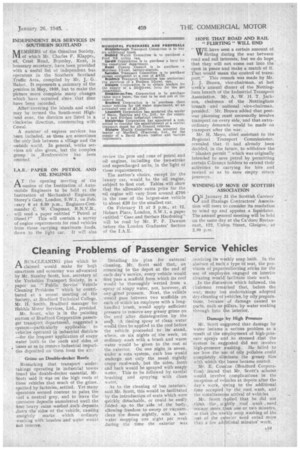Cleaning Problems of Passenger Service Vehicles
Page 21

If you've noticed an error in this article please click here to report it so we can fix it.
ABUS-CLEANING plan which he claimed would make for boil' smartness and economy was advocated by Mr. Stanley Scott, hon. secretary of the Yorkshire Transport Society, in a paper ou " Public Service Vehicle Cleaning Problems " which he contributed at a recent meeting of the Society, at Bradford Technical College. Mr. II. Smith, Bradford manager for Hebble Motor Services, Ltd., presided.
Mr. Scott, who is in the painting section of Bradford Corporation passenger transport departmenl, suggested a system—particularly applicable to vehicles operated in industrial districts —for the frequent application of soapy water both to the roofs and sides, of buses so as to remove industrial impurities deposited on them from the air: Grime on Double-decker Roofs Reniarking that transport undertakings operating in industrial towns found the double-decker essential, Mr. Scott said it was on the high roofs of these vehicles that much of the grime, eptitted by factories, settled. Yet many operators seemed content to paint the roof a neutral grey, and to leave the corrosive deposits unmolested until the first heavy rains washed such deposits down the sides of the vehicle, causing unsightly marks which ordinary washing with brushes and water would not remoye.
Detailing his plan for external cleaning, Mr. Scott said that, on ' returning to the depot at the end of each day's service, every vehicle would first pass a scaffold from which its roof would be thoroughly Wetted from a spray of soapy water, not, however, at any „g feat pressure. Next, the vehicle would pass between two scaffolds on each of which an employee with a longhandled brush, would apply suflicient pressure to remove any greasy grime on the roof after disintegration by the soalS. A rinsing spray of clean water would then be applied to the roof before the vehicle proceeded to its stand, where, on six nights of the week, an ordinary wash with a brush and warm water would he given to the rest of the exterior. On one night in seven, under a rota system, each bus would undergo not only the usual nightly soapy roof-wash, but the sides, front and back would be sprayed with soapy water. This to be followed by careful -brushing and spraying with clean or ate
r.
As to the cleaning of bus interiors. ' said Mr. Scott, this would be facilitated by the introduction of scats which were quickly detachable, or could be easily folded up to the side of the body,, allowing freedom to sweep or vacuumclean the floors nightly, with a hotwater mopping one night per week during the time the exterior was receivin its weekly soap bath. In the absence of such[ a type of seat, the provision of paperfoollecting sticks for the l use of employ es engaged on interior cleaning would facilitate their work.
In the discus ion which followed, the chairman remarked that, before the war, many buS undertakings adopted dry cleaning of rehicles, by oily preparations, because i of damage caused to parts, such as Pillars, by water soaking through into the interior.
Damage by High Pressure
Mr. Scott suggested that damage by water became a serious problem as a result of the employment of high-pressure sprays and he stressed that the -system he suggested did not involve high-pressure washing. He failed to see how the uae of oily polishes could completely elirninate the greasy filin with which the buses became coated.
Mr. E. Cousins (Bradford Corporalion) feared that Mr. Scott's scheme would involve complications in the reception of vehicles at depots after the day's work, Owing to the additional time occupied by the roof wash, and the simultaneobs arrival of vehicles Mr. Scott t*plied that he did not f
think -the Ili htly roof wash . need occupy more t an one or two minutes, or that the we, kly soap washing of the rest of the e.1
terior need entail more than a few ad itiortal minutes' work.
1 .tl:1




















































